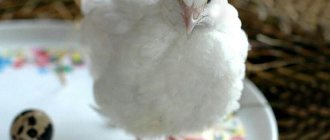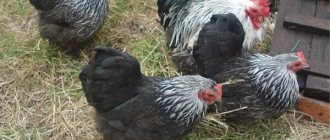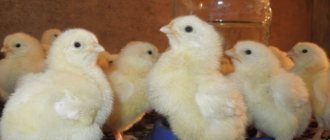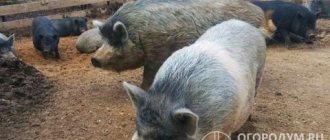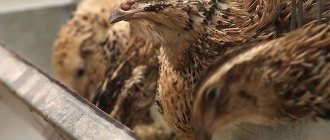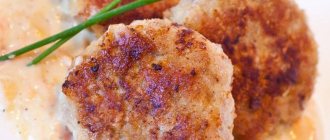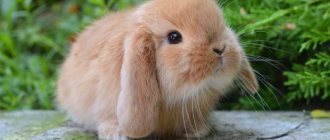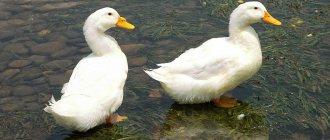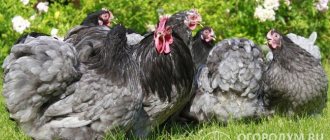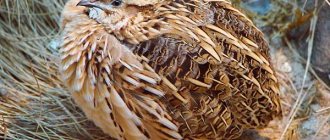Tuxedo quail were developed by breeders by crossing English birds with black and white plumage. English white quails have meat productivity. A bird with black plumage exhibits good egg production.
The tuxedo quail is a universal meat-egg breed. Livestock are bred not only for meat and eggs, but also for aesthetics. They attract attention with their unique plumage color. What are the characteristics of the breed? How to care for quails?
Appearance and performance
The back, wings, and tail of tuxedo quails are dark, and the chest, abdomen and front of the neck are covered with light feathers. This gives the bird a strict and original appearance, due to which it is also bred for decorative purposes. Hens and cockerels are colored the same, so the sex of the young is determined by the presence of a cloacal gland in males.
The productive characteristics of tuxedo quails are such that in terms of egg production, these birds are only slightly inferior to “Estonian” and “Japanese”. Annual productivity is up to 270 pcs. annually, and the weight of the egg is from 10 to 11 g. In the presence of a male, up to 90% of the production is fertilized.
The weight of a cockerel that has reached ideal productive conditions is from 180 to 210 g, and that of a laying hen is from 200 to 220 g.
Benefit
Quail meat is a valuable dietary product and is classified as a delicacy. Tuxedo quail meat is high in calories and is valued much higher than chicken and rabbit meat, as it has high taste. It was not for nothing that quail carcasses were served on the table of kings and nobles. In Rus', quails were caught by hunting.
By eating quail meat regularly, you can significantly improve your health. It is prescribed as a therapeutic food for diseases of the heart, liver, kidneys, and lungs. The meat contains potassium, phosphorus, and B vitamins, which improve the condition of the nervous system. Quail meat is indicated for pregnant women, growing bodies, and people leading an active lifestyle.
Due to the presence of iron and vitamin PP, which improve blood composition and normalize the functioning of the heart and blood vessels, tuxedo quail meat is included in the diet for anemia and in the diet of older people. Quail meat can be consumed by patients with diabetes, as it is well absorbed without loading the pancreas.
Tuxedo quail eggs are superior in value to chicken eggs. They contain essential amino acids and fatty acids that our body does not produce, but they are necessary for the balanced functioning of the body. Quail eggs contain a significant amount of B vitamins, vitamin A, magnesium, and iron. Quail eggs should be consumed for prevention and in the presence of anemia, headaches, problems with the stomach and intestines, and diabetes.
Tuxedo quail eggs and meat do not cause allergic reactions. The description of the beneficial properties can be continued for a long time. Of course, eating quail products is not a panacea, but it is quite possible to improve the condition of the body. Quail eggs store well; at room temperature they do not spoil for a month; they can be stored in the refrigerator for more than 2 months.
Conditions of detention
Description of the tuxedo quail breed in terms of living conditions will be typical for all domestic quails. Like other representatives of this species, black and white birds love warmth. A comfortable temperature for them is from +20 to +25 oC. If it gets colder, the birds will start to get sick and stop producing eggs. They also do not tolerate heat well.
Tuxedo quails can be kept on the floor, in an aviary, but it is better in cages stacked on top of each other in 3-4 floors. This will allow you to place more individuals on each unit of area, and will also make it easier to care for the livestock.
To keep one feathered family, consisting of 1 cockerel and 4 females, a cage measuring 0.3x0.3 m and a height of 0.25-0.3 m is enough. Feeders and drinking bowls are traditionally installed inside, but if they are attached outside , birds will not rake and throw away food, or clog drinking water containers.
Description of the breed
This species received its name due to the color of the plumage, which is mainly brown, and the white feathers found only on the head, chest and neck make this quail appear to be wearing a gentleman’s jacket, hence the name – tuxedo.
Often the color of the feather can be gold, blue or fawn. The breed was obtained by merging white and black English quail. Due to its attractive appearance, the bird has become widespread not only as a meat breed, but also as an ornamental breed, combining all the advantages of the types of birds from which it originated.
About
Where to place the cells
Quails are shy, and representatives of the tuxedo breed are no exception in this sense. Sharp sounds, constant noise, excessive attention from people, as well as visits from small predators are stressful for them and cause a decrease in egg production. Frightened birds eat poorly and lose weight. To prevent this from happening, the cages are placed in a room where the birds will be quiet and calm.
The room must certainly be ventilated, but without drafts. In winter, additional heating will be required. When turning on electric heaters, it is important not to forget about maintaining optimal humidity, ranging from 50 to 70%. To do this, bowls with water are placed near the cages, and wet cleaning of the room is carried out at least once a day.
As for lighting, it cannot be bright, since the habitat of quails in natural conditions is tall grass. That is why the cages are placed away from the light source and so that the direct rays of the sun do not fall on the birds. If the room is too light, the quail will become restless, aggressive, and pecking will begin, which can lead to mass death of the livestock.
The recommended length of daylight hours is about 17 hours, both in winter and summer. Wanting to achieve record egg production, some poultry farmers use round-the-clock lighting. However, laying hens that “work” at the limit of their physiological capabilities for a long time consume more feed, and their body wears out more quickly.
Fattening chickens
The main feature of young quails is that literally a couple of hours after birth they can feed on their own. Due to the exceptionally fast growth rate and for proper development, experienced poultry farmers advise feeding them food high in protein, vitamins and minerals.
Newly born children are given:
- cottage cheese;
- ground crackers;
- greenery;
- finely chopped mealworms;
- chopped boiled eggs.
Four-day-old chicks should be given washed river sand.
Loading …
If you want to breed Japanese quail, you should consider some secrets shared by experienced breeders, among which are:
- Adult individuals may be placed in a general herd in such a ratio that there are no more than 5 females per 1 male.
- These birds cannot hatch eggs, so you will need an incubator to breed them.
- During the first few weeks of life, chicks are unable to distinguish between food and sand. Therefore, where the chicks are located, it is prohibited to find any garbage, otherwise they may swallow it and die.
- For normal development and growth, quails need specialized food. As a treat, you can give them corn and barley, millet and chopped boiled liver.
- Birds need to be fed three times a day and given 30 grams of food per bird at a time. Overfeeding leads to a decrease in egg production.
- The water in the drinking bowl must be fresh. It must be changed several times a day, and for chickens, it must first be boiled for several minutes.
- Only fresh eggs need to be laid in the incubator and they should remain there for approximately 17 days. You can check this in a simple way: if a quail egg is fresh, then it will definitely drown in a glass of water. This is how one egg out of all collected is checked, and the tested batch is placed in the incubator.
- It is recommended to take Japanese quails when they are young, as they are too shy. At a young age, they can more easily endure transportation and it is easier for the breed to get used to a new home.
- Usually quails of this species do not get sick, as they are kept separately from other poultry.
- Quails can be kept either in a cage or in an aviary. But, most often they choose the cage option because it is more convenient for transporting birds and breeding.
In general, the Japanese quail breed is quite convenient due to the minimum maintenance costs and unpretentious bird care. At the same time, the farmer can get rapid business development due to the high productivity of these birds.
The maternal instinct was completely lost in the process of selection of Japanese quail. They never sit on eggs. Therefore, chickens are hatched only in incubators. At the same time, the temperature regime is maintained at 37-38°C. Japanese quails hatch on the 18th day of incubation.
At first, the chicks are fed with chopped quail eggs and cottage cheese (from the second day). You can also use the Start mixture for laying hens. When feeding homemade products, the amount of cottage cheese in the chickens' diet is gradually increased within a week after hatching, and the amount of chopped eggs is decreased. From the second week, the chicks begin to be given boiled fish, millet, and grated carrots. In 3-4 weeks. the bird is transferred to an adult diet.
Feeding
In tuxedo quails, like other representatives of this family, metabolic processes occur quickly. That is why they require food that fully meets the body’s needs for protein, vitamins, minerals and other vital elements, as well as providing weight gain and supporting egg production. It’s easier to use ready-made factory-made formulations, because at home creating a complete diet using the entire set of necessary components is not an easy task.
Each tuxedo quail consumes 25 g of food per day. This is not much when compared with the voracious representatives of the Texas breed, which require 35 g. Black and white birds cannot be overfed, as this threatens obesity, sexual inertia in males and a decline in egg production in females. Feeders are filled twice a day.
To ensure that the birds have a varied diet, in addition to grain, they are fed:
- fresh, chopped greens;
- chopped pumpkin, carrots and beets;
- cucumbers and cabbage leaves;
- nettle and dandelion grass;
- sour milk derivatives;
- other products.
At the same time, the poultry farmer should ensure that there is always fresh drink in the drinking bowls. If there is no nipple drinking system, the water is changed at least 2 times a day.
Meat varieties
They are not as diverse as egg-laying breeds; nature has endowed these birds with small body sizes. Another factor that reduces the interest of breeders in meat breeds is special diets that must be maintained in order to obtain good results.
Nevertheless, the costs invested in breeding meat quails pay for themselves - quail meat is valued on the market. It contains few calories and virtually no cholesterol.
Doctors and nutritionists recommend quail meat to those who would like to:
- to heal;
- strengthen the immune system;
- reduce weight.
Some breeders raise quails only for their tasty dietary meat.
Let's move on to analyzing specific breeds.
Pharaoh
It was not in vain that we started with this breed - today it is one of the most popular. You can’t expect a large number of eggs from laying hens; one hen will lay no more than 200 eggs per year, but the body size of the pharaohs inspires respect:
- about 270 g in adult males;
- more than 300 g in laying hens.
If these values seem small to you, then just compare: wild quail weighs from 80 to 140 g. It is clear that the breeders worked hard, the Pharaoh breed has become a success.
It is used in Russia and other countries. It is worth mentioning that quails of this species have inherited the color of the feathers of their wild counterparts, and as a result, the carcasses do not look very presentable.
Texas white
Sometimes the breed is also called the white Texas giant or the American albino broiler. There is also a more exotic name - white (sometimes snowy) pharaoh. Representatives of the breed look really beautiful – you can admire their snow-white plumage for a long time.
The breed, as you might guess from the name, was bred in the American state of Texas. To obtain it, several breeds had to be crossed at once, among them was the English species - it was from this that the breed received the snow-white color of its feathers. However, there are also small dark spots on the feathers, and the heads of some birds are often colored yellowish.
Most poultry farmers consider this species to be the best for breeding birds for meat. Judge for yourself, Texas white quail are famous for the following indicators:
- males can be fattened up to 500 g, although the average livestock figure is 370 - 450 g;
- laying hens - up to 400 g and even more.
This breed is great for beginning breeders. Birds are easy to keep; they do not have high demands on conditions. They gain weight quickly, but you will have to spend money on food if you want stable weight gain.
Other names for this breed are white Texas giant, American albino broiler, or white (sometimes snowy) pharaoh.
You can add to the breed description that:
- The egg of birds of the Texas breed is large, somewhat oblong in shape. The optimal temperature in a sparrowhawk is 22 degrees; if it is warmer, the females lay eggs worse;
- meat breast is valued as a delicacy;
- males are not particularly active with females; for one “boy” there are usually two “girls”. Keep this in mind if you are thinking about breeding.
Let's summarize. If you started breeding quails for meat, this is the best of the different breeds.
On a note. Until birds of this breed begin to lay eggs, it is impossible to understand where the males are and where the females are.
Moscow black breed
It is unlikely that representatives of the species can be considered a full-fledged breed. Experts are inclined to conclude that this is just a cross between one breed and another - presumably a mixture of black and white English and Hungarian Pharaoh, and he took a little from each type of quail.
It turned out well, in any case, the breeders who took the risk of acquiring eggs from the Moscow black breed were satisfied.
A brief description of:
- Moscow black broiler is a meat bird;
- during fattening, individuals reach: females from 350 to 500 g of live weight, males: from 300 to 400 g;
- egg weight from 12 to 15 g;
- “families” can be composed of one male for three girls;
- egg fertilization – 95%;
- egg production – 75%.
Representatives of this species are the largest individuals in the quail family. In appearance they resemble tuxedo quails, the color of the feathers is beautiful, and therefore the carcass looks quite marketable.
Care
The tuxedo quail, photos of which are presented here and below, will be healthy and maintain the purity of its plumage if the owner regularly cleans the cage where the bird is kept. If daily cleaning is not possible, it should be done 3 times a week, but not less often.
Sanitation of the entire premises is carried out once a month. To prevent ectoparasites, birds are given weekly dust baths. Containers with dry and clean sand are placed in cages so that the quails can clean the fluff and feathers from lice and ticks.
Universal or meat and egg
The main characteristic of egg species is the level of their egg production
For quails of this direction, the quality and quantity of eggs is important. Due to the specifics of the directions, they are bred primarily for the sake of obtaining extremely healthy eggs, but the meat of egg breeds often does not differ in quality from meat directions
However, birds with high egg production are small in size, so it is difficult to obtain a sufficient amount of meat products from them. One of the oldest and most proven egg breeds is the Japanese quail. Representatives of this breed have maximum egg production - over 300 eggs per year. The period of egg production begins after 2 months of life.
Japanese
Birds have a maximum annual egg production of 300-320 eggs. However, the eggs have a small weight, ranging from 8–12 g. The young gain weight quite quickly. With the right diet, after 40 days it can catch up with the weight of adults. Due to the specific coloring of the breast feathers, 20 days after birth, males and females can be distinguished.
English white
Poultry egg production is observed from the age of 40-45 days
The breed was bred in Great Britain and brought to Russia in the 80s. Due to the white plumage, the skin of quails has a pink tint, which gives the carcass an attractive presentation. English white quails weigh more than their Japanese relatives, so they can be used for meat products.
Males weigh on average 160 g, and females can gain up to 180 g. Females begin to lay eggs at the age of 40-45 days. The annual egg production is 280 pieces weighing 10-11 g. The birds are unpretentious in maintenance and feed. The only drawback may be the difficulty in distinguishing males and females for new birders.
There is also a variety of English black quail.
Marble
The breeds of this direction have a very conditional division. Their natural characteristics do not differ significantly from birds producing eggs and meat. Quails of universal breeds have approximately the same parameters in terms of egg production and quality/quantity of meat. They can be bred for egg production or for dietary meat.
Estonian
The Pharaoh is one of the most popular quail breeds, obtained from crossing the Japanese breed, the English White and the Pharaoh. Has a number of positive qualities:
- High probability of egg fertilization (92%).
- Viable young animals, the survival rate of which is up to 98%.
- Unpretentiousness to living conditions and food, excellent immunity.
- Precocity. Females begin to lay eggs at 37-40 days of age.
- High egg production. The bird can lay 300 or more eggs per year, weighing 9-12 g.
- The average weight of males is 170 g, and females are about 200 g. If birds are slaughtered at the age of 4-5 months, you can get juicy, tender meat without excess fat.
- The sex of a bird can be easily determined by the color of its feathers.
Tuxedo
Tuxedo quail is great for small farms
Quails of this species have a characteristic plumage - a dark back and back, with a light spot in front. It is the result of selection of English white and black birds. First of all, it has gained popularity for egg production, but also has meat value in private farms. The weight of the female is 160-180 g, and that of the male is less than 160 g.
Manchurian
Thanks to its light plumage, the carcass has an attractive presentation. The average annual egg production is 220 pieces. The eggs are large in size, their average weight is 16 g. Birds of this breed are characterized by sexual dimorphism - the sex of the chicks can be revealed in the early stages of life. The disadvantage of the breed is the survival rate of young animals - 85%. In general, Manchurian quails have good immunity and are unpretentious to their living conditions.
Phoenix
Many poultry farmers consider this species to be a fiction or a Manchurian quail with a changed name. In fact, the golden phoenix is a broiler branch of the Manchurian quail of French origin. The light yellow plumage of the Phoenix resembles the golden tint of the Manchu, so they are often confused.
However, representatives of this breed are broilers and weigh up to 400 g. The birds grow to their final size 2 months after hatching. Females begin to lay eggs after one and a half months of age. The average weight of eggs is 15 g, but with special feeding they can grow up to 20 g. However, this weight has a bad effect on the health of the bird. Egg production is similar to the Manchurian quail. Thanks to the light plumage, Phoenix carcasses have an attractive presentation.
Breeding
Puberty of tuxedo quails ends by 6-7 weeks of life. It is from this age that laying hens begin to produce eggs, and males become capable of fertilization. Breeding the breed is complicated by the lack of brooding instinct in hens, which, however, is also typical for some other artificially bred bird hybrids. The problem is easily solved by purchasing an incubator or purchasing ready-made young animals from trusted breeders.
Chicks are born on the 17th day from the start of egg laying. If the incubation regime is strictly observed, in terms of maintaining the correct temperature and importance in the apparatus, the quails come into the world strong and healthy, weighing 7-8 g. After the fluff has dried, the young animals are transferred to an insulated box, where they will remain for the first time. Day-old chicks are sorted, selecting weakened and non-viable ones. The first ones are removed and nursed separately, and the second ones, often having congenital anomalies, are disposed of.
Beginning poultry farmers who are taking up the task of caring for tuxedo quails for the first time should take into account that these babies are small but nimble. They easily crawl under a rag-bedding, where they can suffocate and die if the owner does not come to the rescue in time.
By the behavior of quails you can determine when they are hot or cold. At:
- when hypothermic, they gather in a bunch and squeak, pressing tightly against each other;
- overheated, lie on the floor with their necks stretched out.
To avoid dangerous temperature changes, it is recommended to use a lamp with an infrared lamp. After adjusting the height, the heat source is secured above the box or brooder with chicks, and then turned on.
In the first 10 days, the temperature is maintained within 35-38 °C, and then it is gradually reduced so that by the time the chicks are one month old, the thermometer is at 20-25 °C, as for adult birds.
Diseases
Quails have high immunity, but when kept with other birds, tuxedo quails can suffer from helminthic or other parasitic diseases.
Helminthiasis – infection with intestinal parasites:
- manifested by weight loss, possible diarrhea, changes in behavior;
- the poultry is fed with antiparasitic agents;
- Some poultry farmers advise carrying out preventive deworming every six months.
Mallophagosis – infection with a downy feather eater:
- the bird behaves restlessly, constantly shakes itself, itching and feather loss are observed;
- sick quails are treated with external insecticides, the room is disinfected;
- For prevention, place containers with ash and sand.
- Parasites
- Infectious
- Other
Worms (helminths)
Roundworms that cause various diseases and, as a result, serious disorders in the body of birds
Read
Pere-eaters
How to deal with them using folk methods? How can I prevent parasites from appearing again?
Read
Mite
Diseases caused by the parasite. Symptoms, treatment, recommendations for prevention
Read
Newcastle disease (pseudoplague)
What is it and how to avoid infection? Main characteristics of the disease
Read
Pullorosis
Description of the disease, symptoms, treatment, preventive measures
Read
Aspergillosis
An infectious disease that affects the respiratory organs and leads to the death of the bird
Read
Psittacosis
Disease with severe respiratory disorders
Read
Salmonellosis
Symptoms of acute and permanent forms of the disease, treatment and prevention
Read
Colibacillosis
How to identify the source of the disease, how to cure a sick bird and immediately take preventive measures?
Read
Smallpox
Causes, symptoms of various forms, preventive measures and treatment methods
Read
Pecking
How does behavior disorder manifest itself, why is pecking dangerous and how to eliminate it?
Read
Rickets
A chronic disease characterized by impaired calcium-phosphorus metabolism
Read
Inflammation of the oviduct (salpingitis)
An inflammatory disease that can be effectively treated in the early stages. How to cure and restore egg laying?
Read
Feeding features of young animals
It is not difficult to feed tuxedo quails if you use a ready-made factory diet for adult quails. It is sold in granules, so before giving it to the chickens, this feed is crushed into small grains. Compound feed for turkey poults is suitable as a replacement, as it is more nutritious compared to ready-made diets for chicken offspring.
For quails, food is poured directly onto the bedding or into a container with low sides. Water is poured into a shallow plate so that chicks that accidentally fall into it do not drown. You can use plastic cylinder caps. A standard chicken drinker with small pebbles placed in the groove is also suitable.
For the first half a month, tuxedo chicks require round-the-clock lighting, moderately bright. Next, the daylight hours are gradually reduced, bringing its duration on the 30th day to 17 hours.
If you properly care for the young population of tuxedo quail, its safety will be close to 100%. Such a high figure is hardly achievable when it comes to other types of poultry.
Japanese subspecies
The Japanese quail is considered the ancestor of all modern poultry. She got her name because of the place where she was bred. Scientists have worked to qualitatively improve egg production. Further breeding and selection work made it possible to improve the parent subspecies and create other varieties.
Quail is very unpretentious in maintenance. The color of its plumage is close to that of its wild “relative”. It combines ocher, brown, brown and white strokes. There are several dark brown spots in the crop area. The bird's body is elongated, its tail and wings are short. The feet are pink, the beak is dark, and the eyes are dark brown.
Japanese quail under optimal conditions demonstrates record egg production: 300 or more pieces. in year. The product is small, from 8 to 12 g. And the birds themselves are small: males weigh 115-120 g, females weigh no more than 145 g. Puberty and egg laying in laying hens occurs at the age of 1.5 months.
Attention! On average, 90% of Japanese quail eggs are fertilized. Chick hatch rate is 70%
Buying quails
Beginners are almost always very tempted to buy day-old chicks or even hatching eggs. I would still like to warn against this: yes, it is interesting to raise babies, and even more so to watch the hatching process, but there are too many difficulties for an inexperienced poultry farmer!
No matter how much you want to care for the squeaking babies, grit your teeth and start with only grown-up young animals, and ideally, chickens at 45-60 days. And having gained experience and understood whether you need quails at home in principle, you can move on to more responsible and complex steps.
Often people have no idea what awaits them in reality. On websites on the Internet and in books, there are beautiful descriptions of the benefits and problem-free nature of singing. And the nuances of care, such as disposal of droppings, dust from feed, noise and the need for daily care, can ruin delicious eggs and healthy meat for some.
If you are not waiting for a hatching egg, it is better to keep same-sex pets. Quails do not need males to lay eggs properly.
Chinese painted quail
In addition to Japanese quails, painted Chinese birds with a red belly and rich tints of colors on the neck and back are widely known in the world today. Unlike Japanese quails, which are polygamous, this bird prefers to spend its entire life with a single chosen one. Quails are unpretentious and easily adapt to different living conditions, jealous of their own housing and its protection.
Since these quails are quite small, selection work is currently underway in Asia and Europe to breed breeds with the best meat and egg characteristics.
